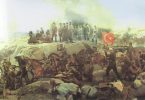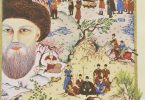In the second half of the 19th century, Ottoman Turkish literature had a fast encounter with modern story and novel
genres. First Turkish novels were written in a period of 25 years from 1875 to 1900. This fast encounter is discussed in many studies on Reform Era literature, and novels written in these years were compared to their contemporaries in Europe while the criticism mostly focused on their weaknesses. However now we see that novel became the most popular literary genre within 25 years and took a long way in such a short period.
Among names who established the genre in the last quarter of the century are Ahmet Mithat, Namık Kemal, Sami
Paşazade Sezai, Recaizade Ekrem and Nabizade Nazım. Ahmet Mithat undoubtedly played a major role in making the genre widespread and popular. Each of the names mentioned, although some not well-known today, is still regarded as cornerstones in birth of Turkish novels. However Halit Ziya Uşaklıgil’s novels have a special place in establishing modern novel and making novel a genre which stands to date and has shaped today. Halit Ziya grew up in the last quarter of the century, reading realizmithe names mentioned above, became a representative of the next generation after those names and started writing his first works during their prime. He was raised as the transformation took place which is a major difference from the previous generation. Uşaklıgil started publishing
a newspaper in Izmir when he was only 17-18 years old, and thought and wrote about literature in that newspaper at
such a young age. The primary difference between his works and Ahmet Mithat’s novels which he read growing up, was the realist novel approach he started to shape.
Halit Ziya published his work titled ‘Hikâye’ (Story) in 1880s in which he expressed why realism precedes romanticism, and he sides with realist novels with long and detailed examples. This work is significant for he thoroughly analyses realist works over his own translations as well as introducing the representatives of realism and romanticism and their works. For instance, he discusses Flaubert’s realism and novels by reading passages from ‘Madame Bovary’ he translated; or studies Zola’s ‘Germinal’ in detail.
In this sense, Uşaklıgil is a name who writes novels while thinking about literature and novel, and supports his novel writing with a theoretic approach. As a matter of fact, he started publishing his first novels one after the other in the years he published ‘Hikâye’. Though amateurish, his first novel ‘Sefile’ is the first example of the realist novel trend he discussed in ‘Hikâye’; on the other hand, it is a reckoning with preceding novelists and the conception of novel within the frame of realism. While making references to Ahmet Mithat’s novel ‘Henüz On Yedi Yaşında’ and Namık Kemal’s novel ‘İntibah’, in his novel he opposed the didactic, disciplinary structures of the two novels shaped by the romantic world view. Halit Ziya abandoned this writing position which disciplines, guides and moralizes the reader from his earliest novel. His characters are not punished for being immoral in the eyes of the society. These are characters who pursue their own desires at the risk of going against the social contract, stranded between society’s demands and their individual desires.
First four novels author wrote and published in Izmir (Sefile, Nemide, Bir Ölünün Defteri, Ferdi ve Şurekâsı) are realistic in large part however the influences of romanticism can be observed with narrators who are involved and express their opinions from time to time. In this sense, Halit Ziya’s novel writing evolves with each new novel. The
writer continued his writing career in Istanbul, and he published his first great work ‘Mai ve Siyah’ in Servet-i Fünun
magazine in 1896. It was the same year that the magazine serialized ‘Zehra’ by Nabizade Nazım and ‘Araba Sevdası’
by Recaizade Ekrem. In this novel, Halit Ziya builds a narrator who depicts the story of main character, the poet entirely through the eyes of the protagonist with his focus on him. This narrator allows the reader to get acquainted with the depths of character’s inner world and at the same time points to the distinction between what actually happened and how the character perceived the events. ‘Mai ve Siyah’ is the first successful example of realist novels in which Halit Ziya pulls the narrator to the background, and steers for detailed analyses of characters’ inner worlds. Halit Ziya Uşaklıgil was to become a founding figure for Turkish novel as his novel writing reached its peak with ‘Aşk-ı Memnu’ and ‘Kırık Hayatlar’. Undoubtedly it is not only his realist approach that made him a founding figure in our literature.
Another reason he is regarded as the trendsetter of realism is him narrating the individual and their inner worlds. In his novels Halit Ziya depicts characters with desires who pursue them. As he depicts the stories of the modern individual also described by his contemporaries Flaubert, Stendhal, and Balzac, he draws portraits of individuals who belong “here”, to the society he lived in. His desirous individuals are the Ottomans who experienced modernism
towards the end of the century. He deals with understanding and narrating man from his early novels. All his novels and stories are on “human experience”. He constructs a novel with narrators who approach characters without value
judgment, and try to express the motives behind their actions, where reader is invited to understand the inner world
of the character instead of a lesson of discipline. This way Halit Ziya formed an autonomous literature contrary
to approaches that instrumentalise literature, and make it an ideological tool.
As I mentioned earlier, Halit Ziya was not just a novelist: he thought, wrote about literature and taught literature.
Histories of French, Greek and Latin literatures he wrote were based on the history of literature lessons he gave in
the University. He also wrote essays on language, literature, grammar, music and painting. For Halit Ziya, literature
is an experience lived and perceived in accompany with other art forms. These essays question and deals with this
collaboration. He collected these essays in the volumes titled ‘Sanata Dair’ as well as including piece introducing the
prominent figures in Turkish and World literature with short biographies. This diversity makes Halit Ziya a witness of the social, political and intellectual life of the century he lived in which is the last century of the Empire and a subject of the modern experience of the 19th century.
Although the autonomous literature experience shaped by Halit Ziya Uşaklıgil was interrupted with rise of nationalism in the following century and decades-long wars, it was revitalized by the generations that followed after his passing. In this sense it would not be wrong to say that Ahmet Hamdi Tanpınar, Yusuf Atılgan, Sait Faik, Oğuz Atay who depict the story of the modern individual, more accurately the milestones of the modernist literature
followed this path of autonomy opened by Halit Ziya.
* Boğaziçi University Department of Turkish
Language and Literature Faculty Member









Leave a Comment